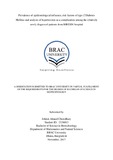| dc.description.abstract | Diabetes is a major health concern all over the world with a huge number of people being freshly
diagnosed each day. This research work evaluates the epidemiological influence, risk factors and
hypertension as a complication associated with type 2 diabetes mellitus, through a bio-statistical
perspective of analysis. The primary characteristic of type 2 diabetes mellitus is a constant
fasting blood glucose on repeated testing, which remains at or above 7.0 mmol/L.
The patients concerned in this study had a constant fasting blood glucose of 7 and above upon
repeated medical testing and hence they were diagnosed with type 2 diabetes mellitus. The study
was based on the data of 17401 type 2 diabetic patients, ranging from 18 to 70 years old.
Variants taken into consideration were: age, sex, educational background, marital status, number
of family members, occupation, family expense, area of residency (childhood and adulthood),
social class, levels of physical exercise, resting heart rate, BMI, smoking habits, tobacco habits,
family history of diabetes, systolic blood pressure, diastolic blood pressure, fasting blood glucose
level, serum alanine transferase levels, serum creatinine levels, total cholesterol levels and
hypertension (complication). The data was collected from the department of Epidemiology and
Biostatistics, from BIRDEM hospital. The data was then cleaned thoroughly for errors and
erroneous data values. Then the data of 17401 type 2 diabetic patients was selected and prepared
for further analysis.
The study found that a dominant percentage of the patients exhibited rural residency (52.3%),
sedentary occupation (44.5%), low family expenditure (37.8%), lower middle socio-economic
status (57.5%), lower levels of physical exercises (47.9%), among the relatively newly diagnosed
type 2 diabetes patients. However, BMI, cholesterol levels, resting heart rate, serum creatinine
and serum ALT levels was seen to be normal among the dominant percentage of diabetic patients
in the study. The female diabetic patients were seen to be overweight and obese in a greater
percentage (19.7% and 8.2%), as in comparison to the males. The analysis also exhibited that,
the percentage (34.4%) of patients with type 2 diabetes was the highest in the age group of 41-
50. The research work also found that, 22% (3825) of the diabetic patients had developed
hypertension among which, the females in comparison to the males, were seen to be in a
dominant percentage (54.8%), developing hypertension as a complication. A dominant
percentage (84.4% and 83.7%) of the patients suffering from type 2 diabetes or hypertension as a
complication, denied smoking or tobacco use. Physical exercise and an active occupation, was
found to constitute a lower percentage among the hypertensive type 2 diabetic patients.
Percentage of patients with hereditary association of hypertension or diabetes was found to be
very low as well (below 20%). Lower middle class rural people, with much lower levels of
literacy and lower family expenses having type 2 diabetes, were seen to be in a greater
percentage for the development of hypertension, as compared to the urban people. The
percentage (67.4%) of patients with normal cholesterol levels was very high among the
hypertensive diabetic patients. Diastolic blood pressure was found to be in the normal range for
the dominant percentage (66.5%) of the diabetic patients whereas, a greater percentage (40.5 %)
among them had a higher systolic pressure above the normal level. The analysis also showed that
type 2 diabetic patients exhibited the highest percentage (36.7%) by population for developing
hypertension as a complication, at the age range of 41-50. There is also a moderately high
percentage (31.3%) of the patients who developed hypertension at 51-60 years of age in case of
the type 2 diabetic patients, in the study. | en_US |

